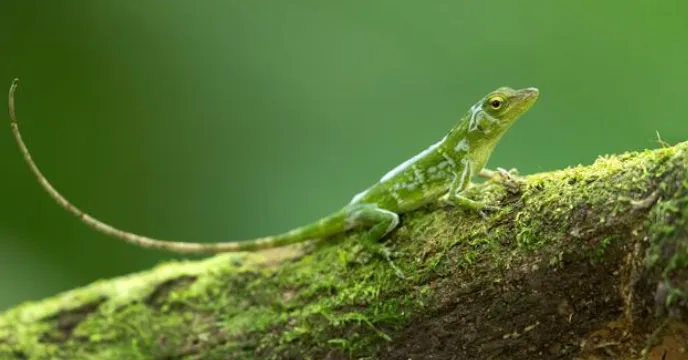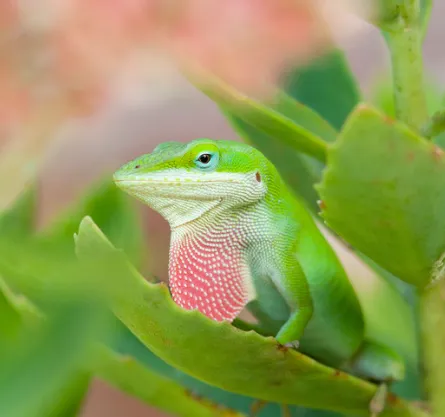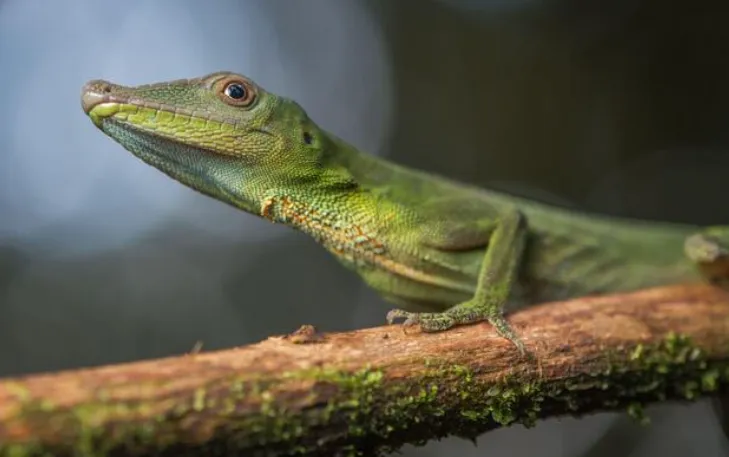
Table of Contents
Diet
Q: What do green anoles eat in the wild?
A: In the wild, green anoles primarily consume a diet of small insects, including crickets, beetles, moths, and spiders. They are opportunistic hunters and will eat any prey that fits into their mouths.
Q: Can green anoles eat fruit?
A: Green anoles are primarily insectivores and don’t usually consume fruit in the wild. It’s best to stick to a diet of insects for optimal health.
Q: How often should I feed my green anole?
A: Juvenile green anoles should be fed daily, while adults can be fed every other day or as they show appetite.
Q: What insects are best for green anoles?
A: Crickets, small roaches, and fruit flies are among the preferred food for green anoles. It’s important to provide a varied diet for optimal nutrition.
Q: Can green anoles eat mealworms?
A: While green anoles can eat mealworms occasionally, they shouldn’t be a staple in their diet. Mealworms have a high-fat content and are not as nutritious as other feeders like crickets.
Q: Do green anoles need calcium or vitamin supplements?
A: Yes, like many reptiles, green anoles benefit from calcium and vitamin D3 supplements. Dust their
Q: How do I gut-load insects for my green anole?
A: Gut-loading means feeding nutritious foods to the insects before offering them to your anole. Feed insects a mix of commercial gut-load products, grains, fresh fruits, and vegetables 24-48 hours before feeding them to your anole.
Q: How much water do green anoles need?
A: Green anoles don’t typically drink from a bowl. They prefer to lick water droplets off leaves. Mist their enclosure daily to provide adequate hydration.
Q: Can green anoles eat vegetables?
A: Green anoles are primarily insectivorous and don’t consume vegetables. Stick to a diet of appropriately-sized insects.
Q: Is it safe to feed wild-caught insects to green anoles?
A: Feeding wild-caught insects can pose risks, such as introducing pesticides or parasites. It’s safer to provide captive-bred feeder insects for your anole.
Q: Do green anoles eat plants?
A: Green anoles are not herbivores; they are insectivores. They don’t eat plants for nutrition but might ingest them incidentally.
Q: How to ensure the
A: Purchase insects from reputable breeders or pet stores, and avoid collecting from areas where pesticides may have been used. If gut-loading, use organic produce.
Q: How many crickets should I feed my green anole?
A: Feed 2-5 small crickets daily for juveniles and 3-7 every other day for adults, adjusting based on the anole’s appetite and size.
Q: Can green anoles eat ants or other small insects?
A: While they might eat small insects like ants in the wild, ants can be aggressive and bite, potentially harming the anole. Stick to recommended feeders like crickets and fruit flies.
Q: What are the signs of malnutrition in green anoles?
A: Signs include weight loss, lethargy, sunken eyes, a thin or frail-looking tail, difficulty shedding, and bones (like the spine or ribs) becoming prominently visible. If you observe these signs, consult with a reptile veterinarian.

Habitat
Q: What type of enclosure is best for green anoles?
A: Green anoles thrive in vertically oriented glass terrariums that allow them to climb and offer proper ventilation.
Q: How big should a green anole’s terrarium be?
A: A single green anole should have a minimum of a 10-gallon terrarium, but 20 gallons is preferable, especially for multiple anoles.
Q: What is the ideal temperature range for a green anole habitat?
A: The ideal temperature range is between 75-80°F during the day and can drop to around 65-70°F at night. A basking spot should be between 85-90°F.
Q: Do green anoles require UVB lighting?
A: Yes, green anoles benefit from UVB lighting, which helps them synthesize vitamin D3 and properly metabolize calcium.
Q: What type of substrate is best for green anoles?
A: Coconut fiber, cypress mulch, or orchid bark work well. Avoid using sand or loose substrates that can be ingested.
Q: How often should I clean the green anole’s enclosure?
A: Spot clean daily for waste and do a thorough cleaning, including changing the substrate, every 4-6 weeks.
Q: How do I maintain proper humidity levels for green anoles?
A: Maintain a humidity level of 60-70% by misting the enclosure daily. Using a hygrometer will help monitor levels.
Q: What plants are safe and beneficial for a green anole terrarium?
A: Safe live plants include pothos, dracaena, and bromeliads. These plants also increase humidity and provide climbing surfaces.
Q: How can I create climbing structures for green anoles in their enclosure?
A: Incorporate branches, vines, and cork bark for climbing. Ensure they’re securely placed to prevent accidents.
Q: Can I keep multiple green anoles in the same enclosure?
A: Yes, but with caution. It’s best to house females together. Males can be territorial and should not be kept together.
Q: Do green anoles need a basking spot?
A: Yes, provide a basking spot with a temperature of 85-90°F using a low-wattage basking bulb.
Q: How to set up a water source for green anoles?
A: Provide a shallow water dish and mist the enclosure daily. Anoles often drink water droplets from leaves.
Q: Are live plants or artificial plants better for green anole habitats?
A: Both can work. Live plants help with humidity and provide a natural environment, but artificial plants are easier to maintain and clean.
Q: How can I create a bioactive setup for green anoles?
A: Incorporate live plants, a drainage layer, a suitable substrate, and clean-up crews like isopods or springtails to break down waste.
Q: How important is ventilation in a green anole enclosure?
A: Essential. Proper ventilation prevents mold growth and maintains air quality. Screened tops are ideal.
Q: Can I keep green anoles outdoors?
A: Only in appropriate climates and with a secure enclosure. They should be protected from potential predators and extreme weather.
Q: What type of hides or shelters do green anoles prefer?
A: They prefer natural-looking hides like cork bark, hollow logs, or leafy shelters.
Q: How do I replicate the natural habitat of a green anole in captivity?
A: Use natural substrates, live plants, proper lighting, and provide climbing structures. Regularly mist to replicate their humid environment.
Q: What kind of equipment do I need to monitor and maintain the environment in a green anole enclosure?
A: A thermometer, hygrometer, UVB lighting, heating source, and timer for lights are essential.
Q: Are there specific materials or decorations to avoid in a green anole’s habitat?
A: Avoid sharp or rough decorations that can injure them, toxic plants, and loose substrates like sand that can be ingested.

Behavior
Q: Why is my green anole displaying its dewlap?
A: Male green anoles frequently display their dewlap as a sign of territory or as a mating signal to attract females. It can also be a show of dominance or a deterrent for other male anoles.
Q: Why is my green anole changing color?
A: Green anoles can change color based on their mood, temperature, and environmental factors. They generally turn bright green when they’re warm and relaxed and may turn brown when they’re cold or stressed.
Q: Is the green anole nocturnal or diurnal?
A: Green anoles are diurnal, meaning they are active during the day and sleep at night.
Q: Why do green anoles bob their heads?
A: Head-bobbing in green anoles is a form of communication. It can be a sign of dominance, territoriality, or a mating display.
Q: Are green anoles territorial?
A: Yes, especially males. They can be quite territorial and will often defend their territory from other males.
Q: Can you handle a green anole?
A: While it’s possible to handle them, green anoles are generally skittish and may become stressed with excessive handling. It’s essential to handle them gently and infrequently.
Q: Why is my green anole always hiding?
A: Green anoles might hide due to stress, the presence of potential predators, or if their environment isn’t set up correctly. Ensuring they have plenty of foliage for cover and that their environmental needs are met can reduce excessive hiding.
Q: Do green anoles communicate with each other?
A: Yes, they communicate through body language such as head bobbing, dewlap displays, and color changes.
Q: Why is my green anole scratching at the glass of its terrarium?
A: This behavior, known as “glass surfing,” can be due to various reasons, including stress, reflection in the glass, or inadequate cage size or enrichment.
Q: Do green anoles play dead?
A: It’s not common behavior, but when severely threatened or stressed, some anoles might “play dead” as a last-ditch effort to avoid predation.
Q: How do green anoles mate?
A: The male will display his dewlap and bob his head to attract a female. If she’s receptive, he will approach her, bite her on the neck, and align their bodies to mate.
Q: Why is my green anole always staying at the top of its cage?
A: Green anoles are arboreal, meaning they naturally prefer being up high. Staying at the top might indicate they feel safer there or are seeking heat if a heat source is above.
Q: Do green anoles get along with other reptiles?
A: It’s not recommended to house green anoles with different species. Even housing multiple anoles together can lead to stress and territorial disputes.
Q: Why do green anoles puff up their throats?
A: Puffing up can be a sign of stress, a defensive posture, or a part of their display behavior, such as when showing their dewlap.
Q: How do green anoles react to their reflection?
A: They may perceive their reflection as another anole and display territorial behaviors like head bobbing or dewlap displays.
Q: What does it mean when a green anole is brown versus green?
A: A green anole turning brown can indicate stress, discomfort, or lower temperatures. Consistently brown anoles should be checked for potential health issues or stressors in their environment.
Q: Do green anoles display signs of stress?
A: Yes, signs of stress can include color changes to dark brown, lack of appetite, lethargy, excessive hiding, and rapid breathing.
Q: Can green anoles cohabitate with other anoles?
A: While it’s possible, there’s a risk of territorial disputes, especially between males. It’s essential to monitor for signs of stress or aggression if housing anoles together.
Q: Why is my green anole not basking?
A: Anoles might avoid basking if they’re feeling insecure, if the temperature is too high, or if they’re not feeling well.
Q: Are there specific behaviors to look for when determining the gender of a green anole?
A: Male anoles typically have a larger, more prominent dewlap and two enlarged post-anal scales. They also display more territorial and mating behaviors compared to females.

Health and Wellness
Q: How long does a green anole typically live?
A: In captivity, with proper care, green anoles can live for 4-8 years.
Q: My anole is staying brown and not turning green. Why?
A: Color change in green anoles can be due to temperature, stress, health, or mood. Persistent brown color can indicate stress or illness.
Q: How often should I feed my green anole?
A: Adult green anoles should be fed every other day, while juveniles might require daily feeding.
Q: Why is my anole refusing to eat?
A: Loss of appetite can result from stress, inappropriate temperatures, or illness. Ensure their habitat is set up correctly and consider consulting a vet.
Q: What’s the ideal temperature for a green anole’s enclosure?
A: The basking area should be between 85-90°F (29-32°C), while the cooler side should be around 70-75°F (21-24°C).
Q: My anole seems to be shedding frequently. Is this normal?
A: Green anoles shed as they grow. Young anoles can shed more frequently than adults. Ensure proper humidity to aid in the shedding process.
Q: How do I ensure my green anole is getting enough humidity?
A: Use a hygrometer to monitor humidity levels. The enclosure should have around 60-70% humidity. Misting the enclosure daily can help maintain this level.
Q: My anole’s eyes look cloudy. What does this mean?
A: Cloudy eyes can be a sign of an upcoming shed. If the condition persists, it might indicate an eye infection or injury.
Q: Are there any specific signs of illness I should watch for in my anole?
A: Lethargy, irregular shedding, refusal to eat, labored breathing, or noticeable weight loss can all indicate potential health issues.
Q: What should I feed my green anole?
A: Their diet primarily consists of live insects like crickets, small worms, and occasional flightless fruit flies.
Q: How can I tell if my anole is dehydrated?
A: Signs might include sunken eyes, reduced activity, and dry, wrinkled skin. Ensure they always have access to fresh water.
Q: My anole has a swollen tail base. What could this be?
A: A swollen tail base, especially in females, can indicate that your anole is gravid (carrying eggs). However, swelling could also be a sign of injury or infection.
Q: Can green anoles get parasites?
A: Yes, like other reptiles, they can get mites and internal parasites. Regular check-ups and clean habitats can help prevent these issues.
Q: Do green anoles need UVB lighting?
A: Yes, UVB lighting is crucial for vitamin D3 synthesis, which helps with calcium absorption, preventing metabolic bone disease.
Q: My anole is limping. What should I do?
A: Limping can indicate injury or a metabolic bone disease. Consult with a reptile veterinarian.
Q: Can I house multiple anoles together?
A: While it’s possible, be cautious. Males can be territorial and fight, so it’s often safer to house them separately or keep multiple females together.
Q: How often should I clean the anole’s enclosure?
A: Spot clean daily for feces and uneaten
Q: Do green anoles need a water dish?
A: While they often drink water droplets from leaves after misting, providing a shallow water dish is still a good idea.
Q: My anole’s jaw looks misshapen. Why?
A: A misshapen jaw can be a sign of metabolic bone disease caused by improper diet or lack of UVB exposure.
Q: Why is my anole’s feces discolored or unusual?
A: Changes in feces can indicate dietary issues, parasites, or other health concerns. If the problem persists, consult a vet.
- Enchi Ball Python: A Unique and Stunning Morph of Python regius - March 27, 2025
- Emerald Tree Monitor: The Enigmatic Green Guardian of the Rainforest - March 26, 2025
- The Egyptian Cobra (Naja haje): A Fascinating Serpent - March 25, 2025
